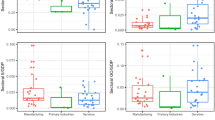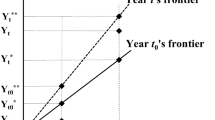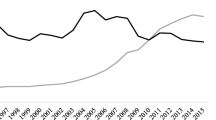Abstract
This study examined the dynamic changes of total factor productivity (TFP) in 53 countries along the “Belt and Road” Initiative from 2001 to 2018. Our findings are as follows: The TFP in most countries and regions dropped significantly after the international financial crisis, but it has shown an overall upward trend since 2013 the “Belt and Road” Initiative. A counterfactual test confirms that the Belt and Road Initiatives have had a significant growth effect on the TFP of these countries. Based on the gravity model and Levinsohn and Petrin (2003) method, this study explains the potential channel of the import of intermediate products in the region under the initiative to promote TFP in countries from a theoretical perspective. Because of the national characteristics, the import of intermediate goods in the region may not have an obvious effect on the growth of TFP, but as the time goes on, there is a positive effect of the Belt and Road Initiatives.


Similar content being viewed by others
Notes
Southeast Asia includes the Philippines, Cambodia, Malaysia, Myanmar, Thailand, Singapore, India, and Vietnam; East Asia includes Mongolia and China; South Asia includes Pakistan, Bhutan, Bangladesh, Nepal, Sri Lanka, and Indonesia; West Asia includes Emirates, Oman, Azerbaijan, Bahrain, Georgia, Qatar, Kuwait, Lebanon and Indonesia, Cyprus, Saudi Arabia, Turkey, Armenia, Iran, Israel, and Jordan; Central Asia includes Kazakhstan, Kyrgyzstan, and Uzbekistan; Europe includes Estonia, Belarus, Bulgaria, Poland, Russia, Czech Republic, Croatia, Latvian, Lithuanian, Romanian, Macedonian, Moldova, Serbia and Sri Lanka Lovak, Slovenia, Ukraine, Greece, and Hungary; Africa includes Egypt.
For details, please refer to Levinsohn and Petrin. Estimating Production Functions Using Inputs to Control for Unobservables [J]. Review of Economic Studies, 2003.
References
Acemoglu D, Aghion P, Violante GL (2001) Deunionization, Technical Change and Inequality. Cepr Discussion Papers
Ackerberg DA, Caves K, Frazer G (2015) Identification properties of recent production function estimators. Econometrica 83(6):2411–2451
Anderson JE (1979) A theoretical foundation for the gravity equation. Am Econ Rev 69(1):106–116
Bu Y (2006) Fixed capital stock depreciation in developing countries: some evidence from firm level data. J Dev Stud 42(5):881–901
Chao J, Yisheng L (2019) The relationship between import trade and innovation research and development in China and major countries along the “One Belt And One Road.” Sci Technol Progress Countermeas 36(24):27–36
Chen Z, Guo S (2012) Review of the research on the impact of financial development on total factor productivity growth. Econ Trends 8:129–136
Feyrer J (2007) Demographics and productivity. Rev Econ Stats 89(1):100–109
Hall RE, Jones CI (1999) Why do some countries produce so much more output per worker than others. NBER Working Paper 114(1):83–116
Hsiao C, Ching HS, Wan SK (2012) A panel data approach for program evaluation: measuring the benefits of political and economic integration of HK with mainland china. J Appl Economet 27(5):705–740
Hsieh C-T, Klenow PJ (2008) Misallocation and Manufacturing TFP in China and India. 2008 Meeting Papers 121, Society for Economic Dynamics.
Hu RW (2017) China’s “One Belt One Road” strategy: opportunity or challenge for India. China Rep 53(5):000944551769661
Jin K, Shen K (2019) The effect of Chinese enterprises’ transportation investment in “One Belt And One Road” countries: development effect or debt trap. China Ind Econ 9:79–97
Levinsohn J, Petrin A (2003) Estimating production functions using inputs to control for unobservables. Rev Econ Stud 70:317–341
Lv Y, Lu Y, Wu S, Wang Y (2019) The promotion effect of “One Belt And One Road” initiative on outbound investment: Based on the dual difference test of Chinese enterprises’ greenfield investment from 2005 to 2016. Econ Res J 54(09):187–202
Pencea S, Bâlgăr AC (2017) At the intersection of “the Belt” and “the Road”, the International Conference “16+1” as part of Belt and Road Initiative in the context of realization of the Chinese Dream – achievements, challenges and prospects, Belgrade. Institute for Asian Studies and the Centre for Asian and Far Eastern Studies of the Faculty of Political Sciences, Belgrade, Serbia.
Pencea S (2017) Romania-China trade and investment relations against the backdrop of “One Belt, One Road” Strategy. Romanian Economic Business Review, Romanian-American University, vol 12(2), pp 17–28, June.
Pencea S (2017) A look into the complexities of One Belt, One Road Strategy, Global Economic Observer no. Institute for World Economy.
Rodrik D (2014) Home-grown growth: problems and solutions to economic growth: an interview with Dani Rodrik. Harv Int Rev 35(4):82–85
Romer PM (1987) Crazy Explanations for the Productivity Slowdown. NBER Macroecon Annu 2:163–202
Skans ON (2008) How does the age structure affect regional productivity. Appl Econ Lett 15(10):787–790
Yu H (2016) Motivation behind China's ‘One Belt, One Road’ initiatives and establishment of the Asian infrastructure investment bank. J Contemp Ch 26(105):53–368
Zhang J, Jin Y (2005) Retesting the relationship between financial deepening and productivity in China 1987–2001. Econ Res J 11:34–45
Funding
The paper is funded by The National Social Science Fund of China (19CJY025).
Author information
Authors and Affiliations
Corresponding author
Ethics declarations
Conflict of interest
No conflict of interest exits in the submission of this paper, and it is approved by all authors for publication. I would like to declare on behalf of my co-authors that the work described was original research that has not been published previously, and not under consideration for publication elsewhere, in whole. The contributions of all listed authors are the same.
Additional information
Publisher's Note
Springer Nature remains neutral with regard to jurisdictional claims in published maps and institutional affiliations.
Appendix
Rights and permissions
About this article
Cite this article
Wang, S., Chang, Z. & Zhang, X. The Belt and Road Initiatives and the growth of total factor productivity: based on the perspective of the regional import of intermediate goods. Empir Econ 63, 1915–1946 (2022). https://doi.org/10.1007/s00181-021-02197-y
Received:
Accepted:
Published:
Issue Date:
DOI: https://doi.org/10.1007/s00181-021-02197-y




